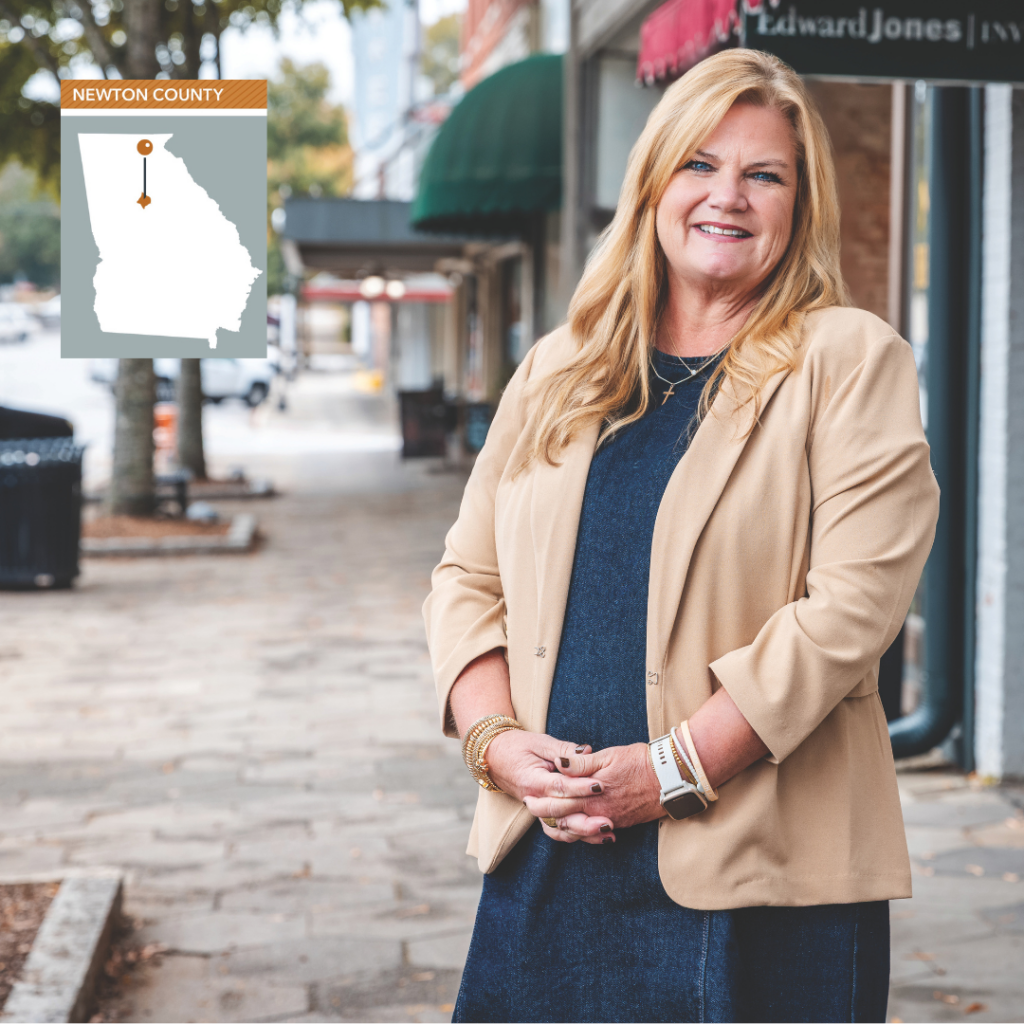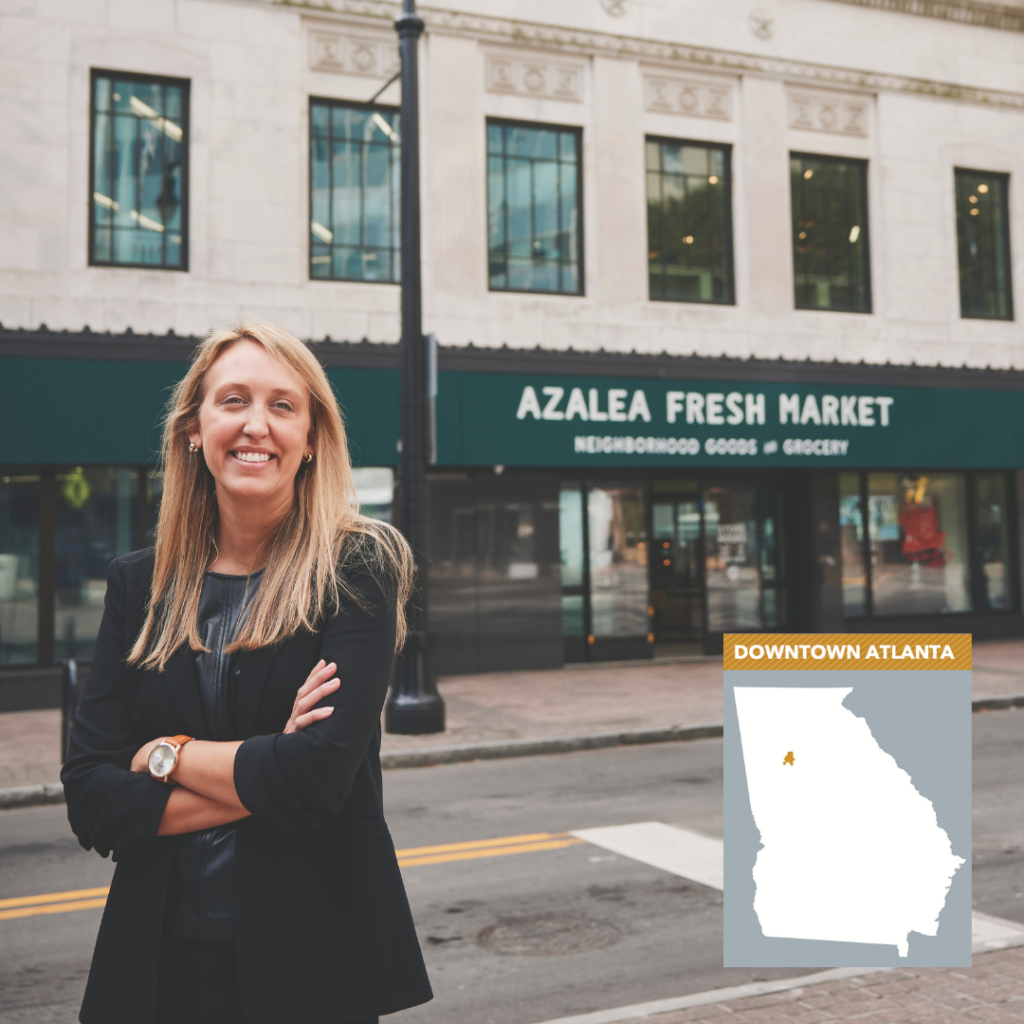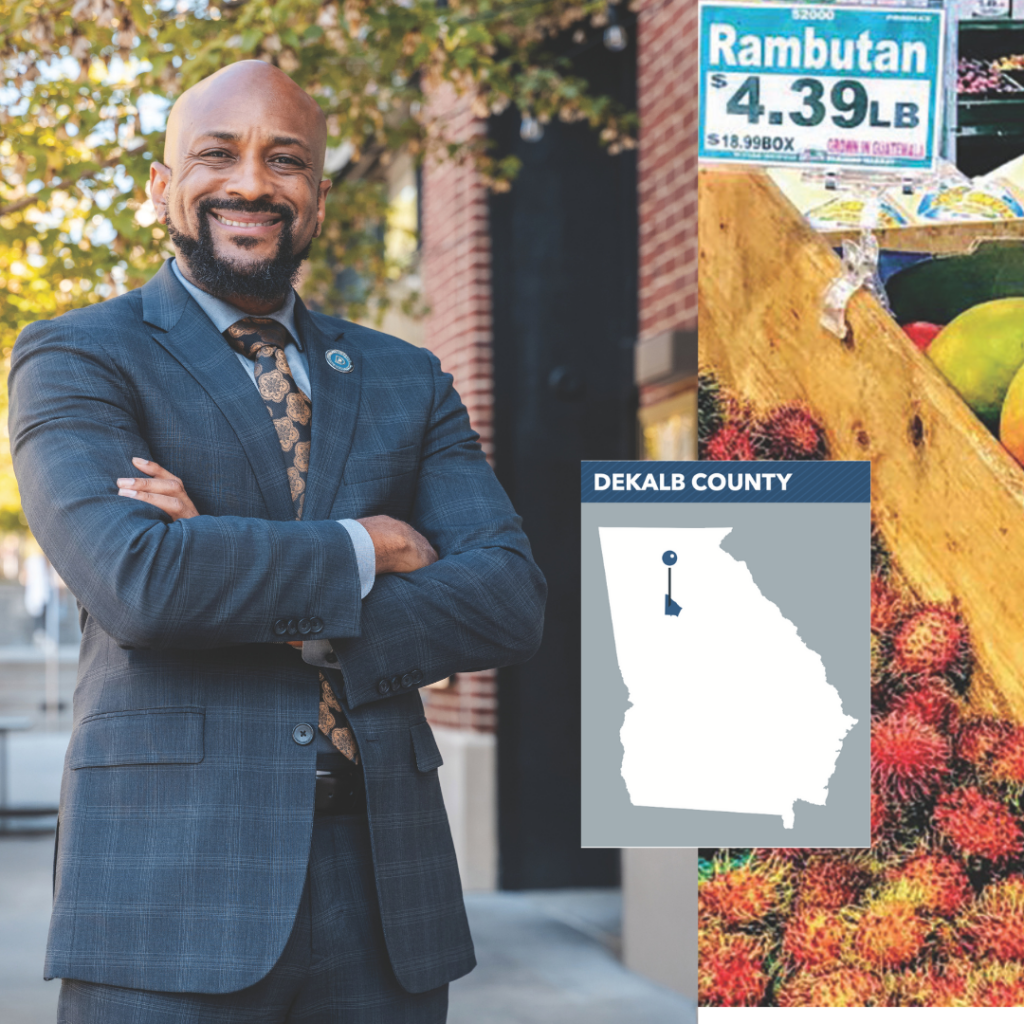Gwinnett County: Creating a Vibrant Future
Innovation, Diversity, Growth
In Gwinnett County, leaders have discovered the recipe for creating a vibrant future: A mindset willing to take risks to stimulate innovation. A pattern of welcoming diversity. A focus on converting dying downtowns into living, walkable hometowns.
That future is growing bigger every day. Gwinnett reached a big population milestone this summer: more than 1 million residents, according to Woods & Poole Economics. (The U.S. Census figures from 2023 are just under 1 million.) And with that number expected to jump even more in the coming years, the county is getting creative to accommodate growth while preserving a sense of community throughout the region and its 16 municipalities.
To get a sense of how much the county has evolved, back in 1990 Gwinnett had a population of 353,000 and was about 90% white. Today the county is a melting pot.
“Our diversity is our biggest strength,” says Gwinnett County Commission Chair
Nicole Love Hendrickson. “Diversity requires a whole-of-government approach to achieve equitable solutions. We actually lead the way on a lot of fronts. Other communities look to us to see how we are driving policies because of our unique challenges.”
 The 2020 Census reveals that 30.3% of the county’s residents are White, 31.3% are Black, 14.1% are Asian, and 23.8 % are of Hispanic or Latino descent.
The 2020 Census reveals that 30.3% of the county’s residents are White, 31.3% are Black, 14.1% are Asian, and 23.8 % are of Hispanic or Latino descent.
“Diversity drives economic development,” says Deven Cason, vice president of economic development for Partnership Gwinnett, the county’s economic development agency. “The biggest driver is a diverse workforce including citizens that speak different languages, which helps to attract companies from foreign countries.”
Europe is the biggest source of international investment in Gwinnett, followed by Asia, North America and South America.
International and Cutting Edge
Gwinnett’s attributes are attractive to companies looking to relocate – and looking to the future.

High-Tech Home: Peachtree Corners City Manager Brian Johnson at Curiosity Lab. Photo credit: Eric Sun
In a coup for the city of Norcross, solar cell manufacturer Suniva decided to restart and upgrade its factory there, drawn by incentives created by the Inflation Reduction Act. The original plant closed in 2017 due to competition from cheaper imports. The reopened plant has created 240 jobs. Its production capacity is now around 1 gigawatt per year with an additional 2.5 gigawatts to be added in a second phase.
The Norcross area was also selected by global warehouse automation company HAI Robotics when it moved its U.S. headquarters from California in June to be closer to East Coast and European customers.
Gwinnett also is a source of innovation. Curiosity Lab at Peachtree Corners operates as a “living laboratory” – a real-world proving ground for emerging technologies related to the concept of a smart city and the “city street of the future.” Launched in 2019 on a 500-acre site as a city-owned technology park, Curiosity Lab’s existing 25,000-square-foot innovation center will soon double in size when an adjacent building is acquired, says Peachtree Corners City Manager Brian Johnson.
Recent months have seen a spate of new announcements of partnerships between Curiosity Lab and companies seeking to test or deploy their state-of-the-art technologies on the city’s autonomous, 5G-enabled vehicle test track. They will join an array of companies ranging from startups to major corporations, with opportunities for mutual collaboration, Johnson says.
“We have become well known internationally among companies looking to test or demonstrate their technology,” Johnson says, adding that some use Curiosity Lab as a soft landing pad to enter the U.S. market.

Testing New Ideas: Curiosity Lab is a real-world proving ground for emerging technologies. Photo credit: Eric Sun
Peachtree Corners’ Mayor Mike Mason – a driving force behind the creation of the 12-year-old city – is also celebrating California-based Intuitive’s decision to make Peachtree Corners the site of its East Coast headquarters. Intuitive, which makes robotic-assisted surgery systems for minimally invasive surgical procedures, has had a presence in Georgia for about a decade. The city beat out other contenders to secure the $500 million deal.
The nine-building campus, first announced in 2021, expands an existing facility and includes 1 million square feet of manufacturing and engineering operations and administrative offices. It will have a workforce of 1,200 people with an average salary of $130,000. The campus will also include a training center for visiting surgeons and other medical professionals, generating overnight stays in hotels and meals in restaurants to support local businesses. The project is opening in phases and scheduled to be complete in 2026.
High-tech Ecosystems
The Water Tower, another public/private partnership – this time with Gwinnett County as one of the partners – is also gaining international recognition. The $34 million Water Tower global innovation hub in Buford was launched in 2019 with the goal of creating an ecosystem of water innovation and a hub for research, technology, training and engagement for water utilities, educational institutions and companies, as well as a business incubator. It was paid for through water department capital funds. The campus officially opened in April 2022.
A research trailer donated by Alabama’s Birmingham Water Works – essentially a water treatment plant in a container – opens new opportunities for research on water treatment technologies and process-optimizations, says Water Tower CEO Melissa Meeker.
As of July 1 of this year, The Water Tower’s long-term tenant spaces have been completely leased, Meeker says, also noting that in 2023, it received more than $778,000 in multiyear grants to support cutting-edge research and workforce development. She says now the organization is deciding whether to add more space for new tenants or to create a state-of-the-art training facility for the workforce of the future.
The Water Tower recently cohosted an international conference on the increasingly important topic of cybersecurity related to water. The other hosts were Singapore University of Technology and Design’s iTrust Laboratories, internationally known for expertise in this field.
Yet another hugely ambitious project initiated by Gwinnett County is in the initial stages of a planned 30-year rollout. Rowen is described as a business and innovation hub with a focus on the environment, agriculture and medicine. Established in 2020 and modeled after North Carolina’s Research Triangle Park, by 2035 its leaders envision 18,500 jobs generating $1.65 billion in income.

The Water Tower, a global innovation hub in Buford has received more than $778,000 in grants to support research and workforce development. Photo credit: contributed
The 2,000-acre campus in a woodland setting in eastern Gwinnett managed by the independent Rowen Foundation is located within easy reach of Georgia’s research universities in Atlanta and Athens, which will be able to use Rowen’s facilities collaboratively for research and education.
Rowen’s primary goal is to create a knowledge-based community focused on attracting companies of all sizes in the medical, agricultural and environmental sciences to pursue research and development. Infrastructure installation is well under way, says Mason Ailstock, the foundation’s president and CEO.
To succeed, Rowen must convince companies in these fields to purchase property to build labs, offices or clean manufacturing spaces. With the state’s assistance, Ailstock is working to secure three or four anchor companies to serve as founders and attract others.
At its heart is Rowen Village, a mixed-use development with multifamily housing, retail, restaurants and office space, Ailstock says.

Poised for Success: Mason Ailstock, president and CEO of the Rowen Foundation. Photo credit: Eric Sun
Ailstock is no stranger to the challenges of university and corporate research. He was previously chief operating officer of Research Triangle Park in North Carolina and president of the Association of University Research Parks. He says what distinguishes Rowen from the rest is its scale, the diversity of institutions involved and its singular focus on agriculture, medicine and the environment. He believes officials in Gwinnett have taken a visionary approach not just to Rowen but to The Water Tower and Curiosity Lab as well.
“These are projects that would not happen on their own but require bold leadership,” Ailstock says. “All of these projects will have to live through economic cycles. That is unique, especially in local government leadership.”

Heart of the Community: Rendering of Rowen Village, a mixed-use development in a woodland setting. Photo credit: contributed
Uncertainties Ahead
Gwinnett has transformed through its fast-paced growth, but has also encountered some uncertainties. In May, voters in the northeast corner of Gwinnett approved the creation of a new city of Mulberry. Proponents argued that the community was threatened by “out of control growth.”
Research Hub: Rendering of Rowen’s 2,000 acre campus in eastern Gwinnett County, left, and Rowen Village, which will have multifamily housing, retail, restaurants and office space, right
Mulberry would be the county’s 17th city, its second largest in population and covering the biggest land area. It would also be one of Gwinnett’s wealthiest cities, with a median household income of $121,000, exceeding the county’s median household income of $82,296. However, whether the city actually comes to fruition depends on the outcome of a resident’s multiple lawsuits, which claim provisions of the city’s charter are unconstitutional because they were proposed under a local law instead of a general law that applies to all cities.
Hendrickson, the county commission chair, had called for a feasibility study that would outline more details about the proposed city and its impact, and expressed dismay when that wasn’t done before the vote. While reluctant to comment, in view of the pending lawsuit, Hendrickson says because lawmakers didn’t do their due diligence, voters didn’t receive sufficient information when they approved cityhood.
“We feel there are so many unknown variables in creating a city, based on the potential false premise that there will be no [city] tax. There’s a lot at stake and the county stands to lose. The residents need to understand the service delivery process and how we negotiate the cost of service delivery with the cities,” she says.
Meanwhile, Gwinnett leaders are hoping voters will give them a favorable result on a referendum set for the November ballot. A new initiative for microtransit would create an on-demand ride-sharing service. Residents would be able to order rides by phone for just $3 per trip, to supplement the county’s other transportation services.
The service is already available in Snellville and Lawrenceville, where it has been popular. It has been approved for Norcross and is planned for Suwanee and Sugar Hill. If voters approve the measure in November, it will be extended to cover the entire county, Hendrickson says.
Thriving Town Centers

Legacy Project: Plans are in the works to transform Gwinnett Place Mall into a mixed-use development. Photo credit: contributed
As Gwinnett’s population grows, so does the opportunity for renewed downtowns and community hubs. In May, the Board of Commissioners released its 2045 Unified Plan, intended to encourage sustainable, denser development by identifying 87 “daily communities” in which a resident can access work, goods and services within a 15-minute trip from their home. A report called The Daily Community Framework lays out the plan to redevelop shopping centers and other community hubs to support new housing and amenities, while prioritizing walkability, attractiveness and accessible parking.
In March, the county also reached an agreement with the commercial real estate development firm CBRE to redevelop the moribund Gwinnett Place Mall. A public-private partnership, the self-taxing Gwinnett Place Community Improvement District, will guide the process with input from stakeholders and the community.
“We want it to be unique to Gwinnett – something not seen anywhere else,” says Hendrickson.
Gwinnett already owns 39 acres and is negotiating with stores that own other parcels about whether they wish to keep or sell their portions to the county. “Ultimately, the goal is to redevelop the entire project from the ground up or build around the existing parcels,” she says. “It will be a legacy project.”

Strengthening Downtown: Snellville Mayor Barbara Bender takes a selfie with statues of the city’s founders, Thomas Snell and James Sawyer, at Grove Park. Photo credit: contributed
A number of cities have already taken action to strengthen their downtowns and improve accessibility. “We didn’t really have a downtown,” says longtime Snellville Mayor Barbara Bender. “All we could attract were used car lots. We had to do something to spark quality development or let the area decline.”
In 2021, Snellville found the solution with the aid of developers. The Grove at Towne Center is a $140 million venture due to be completed this year. Its centerpiece is The Grove, a new central park, which connects to existing parks via greenways and neighborhoods.
The second phase of the project, Northside Medical Snellville, opened in September 2023. It includes a 45,000- square-foot medical building and adjacent 7,500-square-foot medical retail building.
Northside Hospital Gwinnett is also changing the face of Lawrenceville, where a new glass-enclosed, 15-story tower is being added above its existing facility, staffed by 1,400 physicians and more than 5,800 employees. The project, scheduled for completion in 2025, will add more than 300 beds for a total of 696. This will make the facility the largest in the Northside hospital system.
A few miles away, a 72,280-square-foot Convocation Center, located on the north side of Georgia Gwinnett College’s Lawrenceville campus, is nearing completion. The $48 million structure, funded by the state, will include a basketball arena with seating for 2,800, among other facilities.
Lawrenceville Mayor David Still says he’s excited about a new $40 million, 120-room boutique hotel with convention space now in development. It is expected to open in 2025. Still also points to new restaurants, a distillery, new apartment complexes and new single-family housing that have located in Lawrenceville.
Norcross, too, has worked to revive the charm of its historic downtown where new multifamily units are under construction. But Norcross’s position close to Interstate 85, Peachtree Boulevard and Jimmy Carter Boulevard has made it a prized location for industrial space, including warehouse and logistics.
“I think the demand for industrial space in the area is unique,” says

Creating a Skyscraper: Rendering of the new tower at Northside Hospital Gwinnett, which is expected to be complete next year. Photo Northside Hospital
Will Newton, business development manager of Norcross. “Even though it is aging compared to newer industrial areas, there is not a lot of vacancy and people are still demanding space there.”
For this reason, Newton welcomed the creation of a new 90,000-square-foot structure at Northbelt Business Park in the Norcross Opportunity Zone. He says half the space has already been taken up as a distribution center by Hilti, a provider of tools and equipment for construction professionals.

Excited About Progress: Lawrenceville Mayor David Still at the Lawrenceville Arts Center. Photo credit: Woodie Williams
In an ongoing effort to enhance its economic impact, the Gateway85 Community Improvement District plans $179 million in infrastructure improvements by 2030. It covers a 14-square mile area spanning the I-85 corridor near Jimmy Carter Boulevard and is estimated to have a $16.6 billion economic impact on the state.
“Not only is the Gateway85 CID an important part of Gwinnett, it is the farthest south and a redevelopment opportunity. It also has the third largest workforce in Metro Atlanta after Buckhead and downtown,” says Nick Masino, president and CEO of the Gwinnett Chamber of Commerce and Partnership Gwinnett.
 With its large and diverse workforce and so many projects creating jobs and improving communities, Gwinnett will continue to thrive as a dynamic place to live and work.
With its large and diverse workforce and so many projects creating jobs and improving communities, Gwinnett will continue to thrive as a dynamic place to live and work.

Prized Location: A new 90,000-square-foot building in Northbelt Business Park in Norcross is home to Hilti, a tool manufacturing company. Photo credit: contributed
Local Flavor
Zoo in the Woods
Visiting the Yellow River Game Ranch in Gwinnett County was a rite of passage for generations of Georgia schoolchildren and their parents. One of them, Jonathan Ordway, who was 6 years old when he first visited four decades ago, would later purchase the park to prevent the resident black bears and other creatures from being euthanized. The original Game Ranch closed in 2017, amid allegations from activists and former employees that animals there were being abused.
Renamed the Yellow River Wildlife Sanctuary, the property is markedly improved, with huge enclosures, well-fed animals and a new river otter habitat. It boasts a one-mile woodland trail that meanders between enclosures that are home to bears – including one of the original inhabitants – wolves, bison, an albino wallaby, kinkajous, lemurs, a family of North American river otters, a herd of fallow deer named after beans like Fava and Pinto, and a host of other creatures large and small.
Staff member Mae Cannon, originally hired as an intern and immediately hooked, seems able to identify the idiosyncrasies of every individual creature, such as which spider monkey was the least friendly and which otter the most talkative.
Younger children can feed and cuddle resident bunnies, and a group of Nubian goats is only too happy to devour lettuce leaves held out to them.
“I wanted it to feel like you were actually out in the woods, so it was like an adventure you went on as opposed to a zoo,” Ordway says.
The four bears who now call the place home inhabit a two-acre enclosure with a pool and waterfall, trees to climb and a shelter. For the wolves and newly arrived otters, Ordway’s friend Johan Marais designed caves and pools that appear natural.
“We build everything beyond the standards of the Association of Zoos and Aquariums,” Ordway says. He tries to add a new feature every six months to a year. He hopes at some point to add an outdoor classroom to further the sanctuary’s educational purpose.
When the Ordway family – Jonathan, his wife Katy and their five children – bought the 25-acre property in 2018, he admits his main experience with animals was his pet dogs. Experienced keepers and other experts were hired to advise and assist, with family helping when necessary. Fortunately, the Ordways’ primary business as an apartment owner and manager, with industrial property in Florida and the Southeast, provided the necessary income.
The investment required to upgrade the utilities, trails and other facilities was well beyond what Ordway had anticipated. But he has no regrets. “I blame it on the bears,” he says. “It was a passion project. I used to come to this place and think what I would do.”
The tens of thousands of guests who visit the Sanctuary each year seem to approve.













